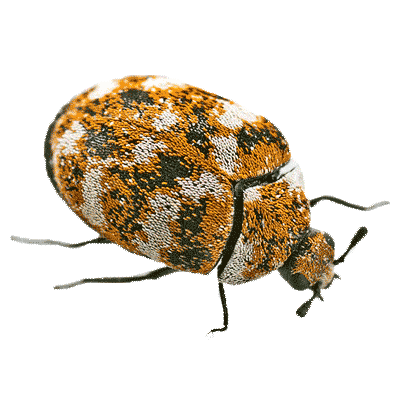Carpet Beetle Control
Adults carpet beetle are not a threat to our textiles. They eat mostly pollen and nectar, preferring flower heads such as Spirea and hogweed. The larvae, however, can do serious damage in the home.
How to identify a carpet beetle and its larvae?
The most common type of carpet beetle in the UK is the Varied Carpet Beetle. As an adult, it ranges in size between 1.7 mm and 3.5 mm. It is small, oval in shape, and looks somewhat like a mottled brown, grey and cream ladybird (see an image). Less common in the UK, there are also Fur Beetles and the Vodka Beetle (Attagenus smirnovi).
The adults lay their eggs in fabrics, bird nests and household fluff. When they hatch into larvae, often known as woolly bears, they will eat the discarded feathers, fabric and fluff before starting to move around the house to find fresh sources of food. This is when they will do significant amounts of damage to your home.
How to identify a carpet beetle problem
You may see adult carpet beetles crowding around sources of light, including windows. They may either be crawling or flying.
More often, you will see the damage done by the woolly bear. This will be well-defined round holes, often along the seams of fabric, as the grubs bite through the threads. Heavily infested areas will have several holes.
Another sign that you have a problem with carpet beetles is discarded larval skins as they grow.
Larvae are most active in October. They are resilient and can survive starvation for several months. The adults are normally seen between April and June. During the winter months they are usually inactive.
How to get rid of carpet beetles
The first line of defence is cleaning. Textiles should be vacuumed to remove eggs and larvae.
Fluff should be vacuumed from airing cupboards, floorboards, upholstery, carpets, etc. In some cases, it may also be necessary to lift carpets to clean beneath them. Don’t forget to make sure that you regularly empty/clean your vacuum cleaner.
In addition to these measures, it may also be necessary to go into the loft to remove bird nests, old carpets, etc.
Do I need professional help?
Larger problems will require professional help. Nesting birds can be a serious problem and will often require a professional pest controller to make your home bird-proof. This will also help with other problems associated with pigeons, parakeets and nesting birds.
Large infestations will require the use of insecticides to achieve control. The pest control industry discourages non-professional use of insecticides, as indiscriminate use is creating long-term problems in the environment and with pest resistance.
A professional pest controller will use a considered amount of the chemical and will target them in a way that is safe and effective such as between floorboards and on/under infested or damaged carpets.
Contact us today if you think you have a problem with carpet beetles.
Fun facts about Carpet Beetles
-
The Vodka Beetle (Attagenus smirnovi) gained its nickname after being first described by E. S. Smirnov in Moscow, in 1961
-
The Vodka Beetle is not Russian, it is African
-
Most carpets nowadays have synthetic fibres in them which the carpet beetle larvae won’t eat
-
Adult carpet beetles like pollen and nectar but will also eat rice, cereal and flour.
-
Woolly bears cannot bite you, but their hairy bodies can irritate your skin.
Photo: Varied Carpet Beetle by AJC1 / CC BY-SA 2.0 / Background removed from original
